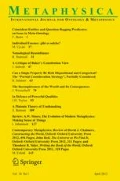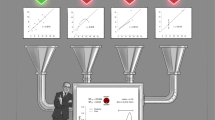Abstract
The distinction between a priori and a posteriori knowledge has been the subject of an enormous amount of discussion, but the literature is biased against recognizing the intimate relationship between these forms of knowledge. For instance, it seems to be almost impossible to find a sample of pure a priori or a posteriori knowledge. In this paper, it will be suggested that distinguishing between a priori and a posteriori is more problematic than is often suggested, and that a priori and a posteriori resources are in fact used in parallel. We will define this relationship between a priori and a posteriori knowledge as the bootstrapping relationship. As we will see, this relationship gives us reasons to seek for an altogether novel definition of a priori and a posteriori knowledge. Specifically, we will have to analyse the relationship between a priori knowledge and a priori reasoning, and it will be suggested that the latter serves as a more promising starting point for the analysis of aprioricity. We will also analyse a number of examples from the natural sciences and consider the role of a priori reasoning in these examples. The focus of this paper is the analysis of the concepts of a priori and a posteriori knowledge rather than the epistemic domain of a posteriori and a priori justification.


Similar content being viewed by others
Notes
See Tahko (2008) for a definition of a priori knowledge in these terms as well as a preliminary account of the bootstrapping relationship.
See also Horvath (2009: 199–201), who suggests that coming to know the metaphysical necessity of propositions will always include a priori elements, even if there may be some a posteriori elements as well. This once again highlights the problem because both a priori and a posteriori elements would seem to be present.
For more discussion, see Tahko (2008).
Here’s one reason why the notion of a posteriori reasoning does not seem to make much sense: our rational capabilities are plausibly independent of experience and the only a posteriori part involved with reasoning is pure perceptual information.
If Philip Kitcher (1984) is right, this is even true of mathematics.
The double-slit experiment is an experiment in quantum mechanics, which demonstrates the wave-particle duality of light.
This also reflects the distinction between the modal status of a proposition and the truth of a proposition, see Horvath (2009) for more discussion.
Gravitational redshift refers to the change in the wavelength of light and other electromagnetic radiation when it travels from a stronger gravitational field to a weaker one.
A more detailed discussion is available in Tahko (2008).
These challenges have been discussed in detail in Tahko (2009).
References
Boghossian, P. and Peacocke, C. (Eds.) (2000) New Essays on the A Priori (Oxford: Oxford University Press).
BonJour, L. (1998) In Defense of Pure Reason: A Rationalist Account of A Priori Justification (Cambridge: Cambridge University Press).
Casullo, A. (2003) A Priori Justification (Oxford: Oxford University Press).
Fine, K. (1994) ‘Essence and modality’ In Tomberlin, J. E. (Ed.) Philosophical Perspectives 8 (Atascadero, CA: Ridgeview), pp. 1–16
Horvath, J. (2009) ‘The Modal Argument for A Priori Justification’, Ratio, Vol. 22, No. 2, pp. 191–205.
Kitcher, P. (1984) The Nature of Mathematical Knowledge (Oxford: Oxford University Press).
Kripke, S. (1980) Naming and Necessity (Cambridge, Mass.: Harvard University Press).
McGinn, C. (1975–76) ‘“A Priori” and “A Posteriori” Knowledge’, Proceedings of the Aristotelian Society, New Series, Vol. 76, pp. 195–208.
Peacocke, C. (2004) The Realm of Reason (Oxford: Oxford University Press).
Priest, G. (2006) In Contradiction: A Study of the Transconsistent, 2nd expanded ed. (Oxford: Clarendon Press).
Tahko, T. E. (2008) ‘A New Definition of A Priori Knowledge: In Search of a Modal Basis’, Metaphysica, Vol. 9, No. 2, pp. 57–68.
Tahko, T. E. (2009) ‘The Law of Non-Contradiction as a Metaphysical Principle’, The Australasian Journal of Logic, Vol. 7, pp. 32–47.
Author information
Authors and Affiliations
Corresponding author
About this article
Cite this article
Tahko, T.E. A Priori and A Posteriori: A Bootstrapping Relationship. Int Ontology Metaphysics 12, 151–164 (2011). https://doi.org/10.1007/s12133-011-0083-5
Published:
Issue Date:
DOI: https://doi.org/10.1007/s12133-011-0083-5




